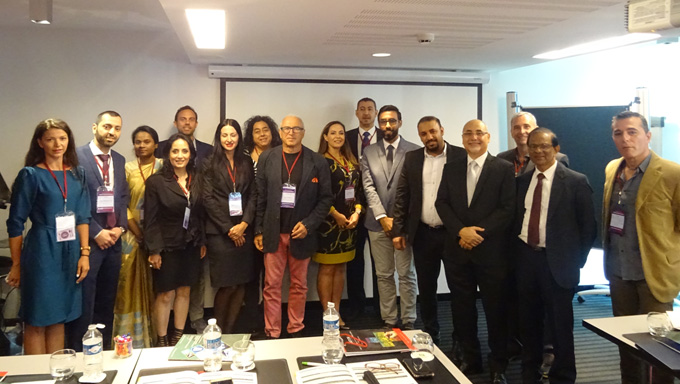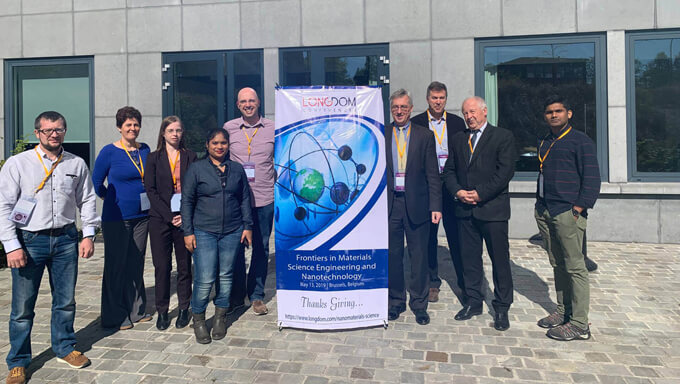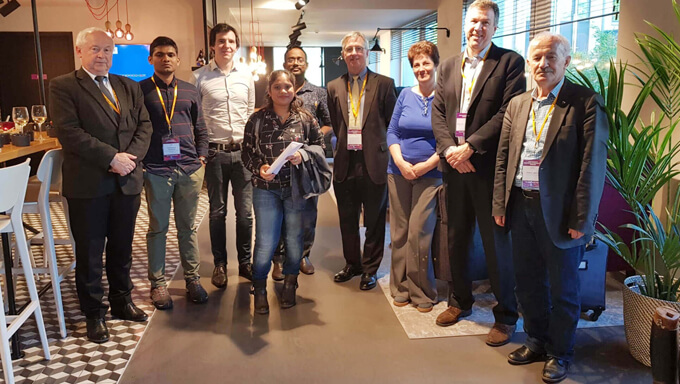







Molecular biology concerns the molecular basis of biological activity between the various systems of a cell, including the interactions between the different types of DNA, RNA and proteins and their biosynthesis, and studies how these interactions are regulated. It has many applications like in gene finding, molecular mechanisms of diseases and its therapeutic approaches by cloning, expression and regulation of gene. Research area includes gene expression, epigenetics and chromatin structure and function, RNA processing, functions of non-coding RNAs, transcription. Nowadays, Most advaced researches are going on these topics: Molecular biology, DNA replication, repair and recombination, Transcription, RNA processing, Post-translational modification, proteomics, Mutation, Site-directed mutagenesis, Epigenetics, chromatin structure and function, Molecular mechanisms of diseases.
Plants are ideal model systems to study the influence of changing environmental conditions on epigenetic patterns. We are especially interested to understand how certain genomic regions become targets for epigenetic modification and how environmental stress affects epigenetic gene regulation. Our applied work investigates how transgene silencing can be prevented and how epigenetic variation can be exploited for novel breeding strategies
Plant produces an enormous variety of natural products with highly diverse structures. These products are commonly termed as “secondary metabolites “which are essential for plant growth and development. Secondary metabolites were formerly regarded as waste products without physiological function for the plant with the emergence of the field of the chemical ecology about 30 years ago. In addition to their physiological function in plants natural products also have a strong impact on human culture and have been used throughout human history as condiments, pigments, and pharmaceuticals.
Multicellular tissue fragments, called explants, obtained from living plants. Explants may originate from wide range of plant tissues, such as leaf, stem, root, hypocotyl, cotyledon, embryo, or meristem. Plant Biotechnology is prominent in the field of medicine interfacing biotechnology and bioinformatics, the molecular characterization of medicinal plants; molecular farming; and result from Plant Biochemistry, nanotechnology, Plant pharmacology, agriculture, Biomass and biofuels as well. Plant tissue culture is the growth of plant cells outermost an intact plant. It depends on maintaining plant tissue in lab conditions on a suitable nutrient medium. The culture can be sustained as a mass of undifferentiated cells for a broad area for a period of time, or regenerated into whole plants. The dissimilar techniques used in plant tissue culture. Plant tissue culture is mostly used to produce clones of a plant in a method known as micro-propagation with different stages. Plant Biotechnology is the technology which is used for getting modern product with high yield and at faster rate.
Plant biotechnology is the product of interaction between sciences of biology and technology.it is the technological exploitation and control of biological systems. An important aspect of all plant biotechnology processes is the culture of either the microorganisms or plant cells or tissues and organs in artificial media
Plant tissue culture is a system of developing plant cells, tissues, organs, seeds or other plant parts in a sterile situation on a supplement medium. Plant Tissue Cultures are generally initiated from.
The complex and different responses of plants to nanoparticles, the signal transduction mechanisms involved, and the regulation of DNA expression. Further, it shows the photosynthesis of nanoparticles, the role of nanoparticles in the antioxidant systems of botany and agriculture, the beneficial and harmful effects of nanoparticles on plants, and the application of nanoparticles and nanotubes to MS, aiming ultimately at an analysis of the metabolomics of plants. The increasing role of inventions in the field of nanotechnology is producing novel applications in the fields of biotechnology and agriculture. Nanoparticles have received much response because of the unique physico-chemical properties of these compounds. In the plant biology, nanoparticles are used as “smart” delivery systems, prompting the Nobel Prize winner P. Ehrlich support to get these components as “magic bullets.” Nanotechnology also play an important role in agriculture as compound fertilizers and minute-pesticides, acting as chemical delivery agents that target molecules to specific cellular organelles in plants.
Plant and Agricultural biotechnology are specific area of plant science involving the use of scientific tools and techniques, including genetic engineering, molecular markers, molecular diagnosis, vaccines, and tissue culture to modify living organisms: plant, animal and microorganism. Agricultural biotechnology is majorly used to alter the genome sequence of crops and those crops can be termed as transgenic or genetically modified crops. Agricultural biotechnology comprises Agriculture genetics and Plant breeding, Agronomy, Agricultural Extension, Agricultural engineering and technology, hybrid seed technology, Agricultural risk management, Modelling tools in agricultural DSS (Decision Support System). Plant breeding is the process of using two parent plants to create an “offspring” plant. It involves manipulation of plant species in order to create desired genotypes and phenotypes for specific purposes. Manipulation involves either controlled pollination, genetic engineering, or both, followed by artificial selection of progeny
Plant pathology is the scientific discovery of diseases in plants caused by pathogens and environmental conditions. Organisms that cause viral disease include fungi, bacteria, viruses, viroids, virus-like organisms, phytoplasma, protozoa, nematodes and dependable plants. A plant considered undesirable, unattractive, or troublesome, especially one that grows where it is no need and often grows or spreads fast or takes the place of desired plants. It is an aquatic plant or alga, especially seaweed.
Plant Pathology is defined as the study of diseases in plant that cause by the pathogens, the mechanisms by which this occurs, the interactions between these causal agents and the plant (effects on plant growth, yield and quality), and the methods of managing or controlling plant disease. It also interfaces knowledge from other scientific fields such as mycology, microbiology, virology, biochemistry, bio-informatics, etc. Plant Diseases caused by plant pathogens like fungi, bacteria, nematodes, viruses, parasitic flowering plants, abiotic factors of the environment including light, temperature, and atmospheric gases. Plant diseases are recognized by the symptoms (external or internal) produced by them or by sick appearance of the plant. The term plant disease signifies the condition of the plant due to disease or cause of the disease. Plant disease is mainly defined in terms of the damage caused to the plant or to its organ.
Structural biology is a part of molecular biology, biochemistry, and biophysics worried about the molecular structure of organic macromolecules (particularly proteins, made up of amino acids, RNA or DNA, made up of nucleotides, layers, made up of lipids) how they procure the structures they have, and how adjustments in their structures influence their capacity. This subject is of incredible enthusiasm to scientists since macromolecules do the vast majority of the elements of cells, and it is just by snaking into explicit three-dimensional shapes that they can play out these capacities. This design, the "tertiary structure" of particles, depends in a confounded route on every atom's essential sythesis, or "essential structure."
Biomolecules are too little to even consider seeing in detail even with the most exceptional light magnifying instruments. The techniques that auxiliary scholars use to decide their structures by and large include estimations on tremendous quantities of indistinguishable atoms simultaneously.
The human ordering is that the complete set of super molecule sequences for humans encoded as polymer among the twenty-three body pairs in cell nuclei and in a very tiny polymer molecule found among individual mitochondria. This area unit sometimes treated on an individual basis because of the nuclear ordering, and also the mitochondrial ordering. Human genetics in the world Health Initiative aims to produce info and lift awareness among the health sector, governments and therefore the wider public on the health challenges and opportunities among the apace developing science of human genetics. The initiative on Human genetics in world Health builds on the previous work of the Human genetic science programmed and therefore the Initiative on genetics & Public Health.
National Science Foundation (NSF) announces its intention to continue to support plant genome research through the Plant Genome .Research Program (PGRP). Plant Genomics Research Program (PGRP) awards from the National Science Foundation (NSF) that NSF offers supplements to support research collaboration with scientist sin developing countries. The intent of Developing Country Collaborations in Plant Genome Research (DCC-PGR) awards is to support collaborative research linking U.S. researchers with partners from developing countries to solve problems of mutual interest in agriculture, energy and the environment, while placing U.S. and international researchers at the center of a global network of scientific excellence.
Bioinformatics is the exploration of gathering and breaking down complex organic information, for example, hereditary codes. Sub-atomic solution requires the joining and examination of genomic, sub-atomic, cell, and additionally clinical information and it in this way offers a momentous arrangement of difficulties to bioinformatics.
We let our ground-breaking work and our amazing clients speak for us…… LONGDOM conferences